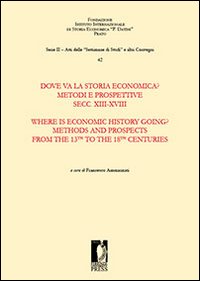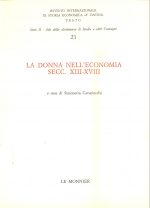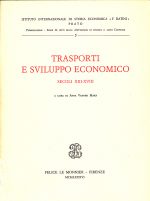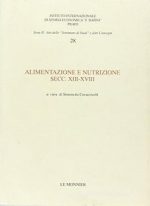APERTURA DEI LAVORI
Giampiero Nigro, L’istituto Datini e la storia economica (secc. XIII-XVIII), p. 3
Giampiero Nigro, The Datini Institute and the Eonomic History (13the-18th centuries), p. 13
Giampiero Nigro, The Datini Institute and the Eonomic History (13the-18th centuries), p. 13
VECCHIE E NUOVE SENSIBILITÀ NELLE DIVERSE AREE LINGUISTICHE: LE TEMATICHE/OLD AND NEW INSIGHTS IN THE DIFFERENT LINGUISTIC REGIONS: THE TOPICS
Alberto Grohmann, Vecchie e nuove sensibilità nella storiografia economica italiana: le tematiche, p. 25
Laurent Feller, Histoire du Moyen Âge et histoire économique (Xe-XVe siècle) en France, p. 39
Jan de Vries, Where Is Economic History Going? Old and New Insights: a Personal Perspective, p. 61
Erol Ösvar, Economic History in Turkey, p. 79
Miguel Ángel Ladero Quesada, La historia económica medieval hispánica, p. 105
Mark Häberlein, Pre-Industrial Economic History in Germany: Trends, Problems and Prospects, p. 143
Jacek Kochanowicz, Anna Sosnowska, Economic History of Pre-industrial Poland: An Obsolete Subject?, p. 153
Hilario Casado Alonso, The Economic History of Spain in the Early Modern Ages, p. 173
Laurent Feller, Histoire du Moyen Âge et histoire économique (Xe-XVe siècle) en France, p. 39
Jan de Vries, Where Is Economic History Going? Old and New Insights: a Personal Perspective, p. 61
Erol Ösvar, Economic History in Turkey, p. 79
Miguel Ángel Ladero Quesada, La historia económica medieval hispánica, p. 105
Mark Häberlein, Pre-Industrial Economic History in Germany: Trends, Problems and Prospects, p. 143
Jacek Kochanowicz, Anna Sosnowska, Economic History of Pre-industrial Poland: An Obsolete Subject?, p. 153
Hilario Casado Alonso, The Economic History of Spain in the Early Modern Ages, p. 173
Discussant
Marco Belfanti, p. 191
VECCHIE E NUOVE SENSIBILITÀ: GLI STRUMENTI/OLD AND NEW INSIGHTS: TOOLS
Mark Ormrod, Government Records: Fiscality, Archives and the Economic Historian, p. 197
Paulino Iradiel, Fuentes de derecho privado: protocolos notariales e historia económica, p. 225
Mathieu Arnoux, Histoire économique et sources littéraires, p. 249
Ramon Josep Pujades i Bataller, Explotación económica y aprehensión intelectual del espacio en la baja edad media y el Renacimiento: el potencial informativo de la cartografía y los textos técnicos de carácter geográfico para los historiadores de la economía, p. 263
Gerhard Jaritz, Old and New Insights: Iconographic Sources, p. 289
Alessandra Molinari, Fonti materiali, archeologia e storia economica: verso quali modelli interpretativi?, p. 307
Bartolomé Yun Casalilla, Reading Sources throughout P. Bourdieu and Cyert and March. Aristocratic Patrimonies vs. Commercial Enterprises in Europe (c. 1550-1650), p. 325
Catherine Verna, Quelles sources pour quelles entreprises du XIIIe au XVe siècle ?, p. 339
Luciana Frangioni, Le fonti aziendali Datini per la storia (seconda metà XIV secolo – inizi XV secolo), p. 373
Gelina Harlaftis, International Business of Southeastern Europe and Eastern Mediterranean, 18th Century: Sources, Methods and Interpretive Issues , p. 389
Paulino Iradiel, Fuentes de derecho privado: protocolos notariales e historia económica, p. 225
Mathieu Arnoux, Histoire économique et sources littéraires, p. 249
Ramon Josep Pujades i Bataller, Explotación económica y aprehensión intelectual del espacio en la baja edad media y el Renacimiento: el potencial informativo de la cartografía y los textos técnicos de carácter geográfico para los historiadores de la economía, p. 263
Gerhard Jaritz, Old and New Insights: Iconographic Sources, p. 289
Alessandra Molinari, Fonti materiali, archeologia e storia economica: verso quali modelli interpretativi?, p. 307
Bartolomé Yun Casalilla, Reading Sources throughout P. Bourdieu and Cyert and March. Aristocratic Patrimonies vs. Commercial Enterprises in Europe (c. 1550-1650), p. 325
Catherine Verna, Quelles sources pour quelles entreprises du XIIIe au XVe siècle ?, p. 339
Luciana Frangioni, Le fonti aziendali Datini per la storia (seconda metà XIV secolo – inizi XV secolo), p. 373
Gelina Harlaftis, International Business of Southeastern Europe and Eastern Mediterranean, 18th Century: Sources, Methods and Interpretive Issues , p. 389
VECCHIE E NUOVE SENSIBILITÀ: I RAPPORTI CON LE ALTRE DISCIPLINE/OLD AND NEW INIGHTS: RELATIONSHIPS WITH OTHER SUBJECTS
Paolo Malanima, Storia economica e teoria economica, p. 419
Mark Thomas, Economic History and Mathematical-Statistical Sciences, p. 429
Guillaume Daudin, Quantitative methods and Economic History, p. 453
Anthony A. Wrigley, Economic History and Demography, p. 473
Michael North, Economic History and Cultural History, p. 497
Mark Thomas, Economic History and Mathematical-Statistical Sciences, p. 429
Guillaume Daudin, Quantitative methods and Economic History, p. 453
Anthony A. Wrigley, Economic History and Demography, p. 473
Michael North, Economic History and Cultural History, p. 497
DOVE VA LA STORIA ECONOMICA? METODI E PROSPETTIVE (SECC. XIII-XVIII)/ WHERE IS ECONOMIC HISTORY GOING? METHODS AND PROSPECTS (FROM 13TH TO THE 18TH CENTURY)
Tavola rotonda conclusiva
Santiago López, Investigationes de Historia Económica – IHE. Journal of the Spanish Association of Economic History, p. 511
Matts Morell, Scandinavian Economic Review, p. 515
Hans Pohl, Vierteljahrschrift für Sozial- und Wirtschaftsgeschichte. Quarterly Review for Social and Economic History, p. 527
Matts Morell, Scandinavian Economic Review, p. 515
Hans Pohl, Vierteljahrschrift für Sozial- und Wirtschaftsgeschichte. Quarterly Review for Social and Economic History, p. 527
Hans Pohl, Where is German Economic History Going? p.531
Antonio Di Vittorio, Dove si proietta la storia economica italiana, p. 533
Laurence Fontaine, La crise du paradigme économique, p. 537
Sergej Pavlovic Karpov, Dove va la storia economica russa?, p. 543
Adam Manikowski, Dove va la storia economica polacca?, p. 547
Antonio Di Vittorio, Dove si proietta la storia economica italiana, p. 533
Laurence Fontaine, La crise du paradigme économique, p. 537
Sergej Pavlovic Karpov, Dove va la storia economica russa?, p. 543
Adam Manikowski, Dove va la storia economica polacca?, p. 547
Abstracts, p.549




